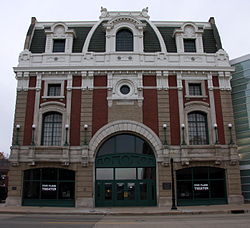Five Flags Center
|
Orpheum Theatre and Site
|
|
 |
|
| Location | 405 Main St. Dubuque, Iowa |
|---|---|
| Coordinates | 42°29′52″N 90°39′55″W / 42.49778°N 90.66528°WCoordinates: 42°29′52″N 90°39′55″W / 42.49778°N 90.66528°W |
| Built | 1910 |
| Architect | Rapp and Rapp |
| NRHP Reference # | 72000474 |
| Added to NRHP | November 14, 1972 |
Five Flags Center is a multi-purpose facility in downtown Dubuque, Iowa. It is named for the five flags that have flown over Dubuque; the Fleur de Lis of France (1673–1763), the Royal Flag of Spain (1763–1803), the Union Jack of Great Britain (1780, during a brief interruption of Spanish rule), the French Republic Flag of Napoleon (1803) & America's Stars and Stripes (1803–Present).
The site's first theater was the Athenaeum Theater, built in 1840, which became the City Hotel (also a theater) in 1846 and later the Peosta House.
A second theatre was originally built in 1864 or 1877, but then was destroyed by fire in 1910. It had been purchased then renovated during 1909-1910 by local prominent businessman Harker Brentnal Spensley, Sr. and his partner, C. H. Eighmey.
The current Great Five Flags Theater was constructed as the Majestic Theater in 1910. The rebuilt theater was designed by George L. Rapp, who eventually became one of the nation's premier theater architects. It was converted to a movie house in 1920 and renamed 'Spensley Theater' in 1929. Constructed in a Renaissance Revival style with French influences, it was later renamed the RKO Orpheum and used to show movies. Eventually, it fell into disrepair and was slated for demolition during urban renewal in 1969.
A committee made up of concerned citizens began a fund drive to save the theater, which was incorporated in the Five Flags Center project in 1972. Restoration was begun in 1975, and the theater was reopened in 1976 as the Five Flags Theater. It is currently the home of the Dubuque Symphony Orchestra, high school musicals, and occasional concerts and ballet productions.
Five Flags Arena was conceived as part of a project to rehabilitate the Five Flags Theater. Construction began in 1976, and the facility opened in 1979. The first event was a concert by Bob Hope.
The arena can seat up to 5,200 for basketball, although in its primary use, ice hockey, actual seating capacity is only about 2,500.
...
Wikipedia


